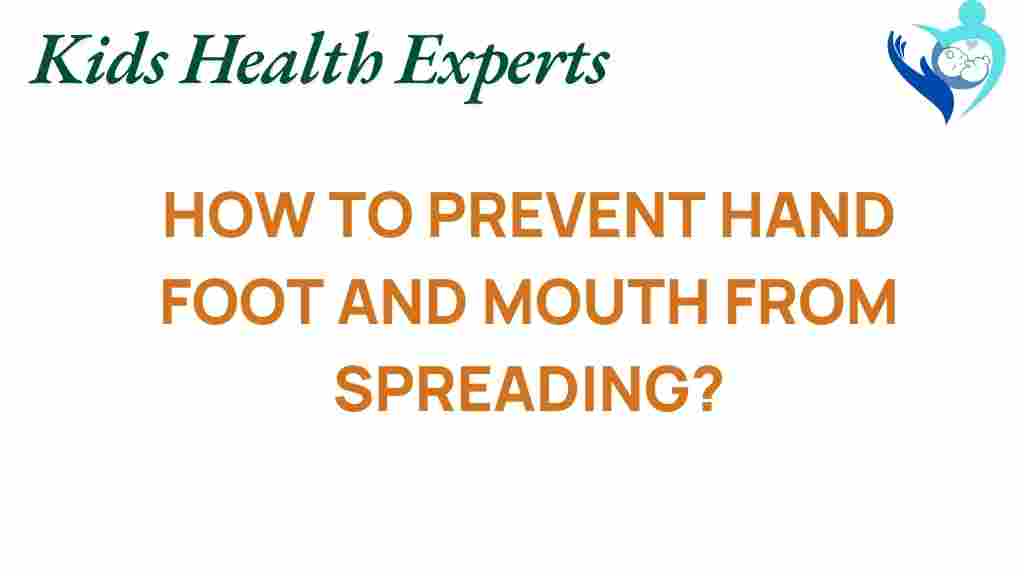Unraveling the Secrets: How to Prevent Hand, Foot, and Mouth Disease
Hand, foot, and mouth disease (HFMD) is a common viral infection that primarily affects children under the age of five. It is characterized by fever, mouth sores, and a rash on the hands and feet. While HFMD is usually mild and self-limiting, understanding how to prevent its occurrence is crucial for parents and caregivers. In this article, we’ll delve into the symptoms, the contagious nature of the disease, and effective prevention strategies to keep your children healthy.
Understanding Hand, Foot, and Mouth Disease
Hand, foot, and mouth disease is caused by several different viruses, most commonly the coxsackievirus. The disease spreads easily, particularly in places where children are in close contact, such as daycare centers and schools. Knowing the symptoms and how to prevent outbreaks is vital for maintaining a healthy environment for children.
Symptoms of Hand, Foot, and Mouth Disease
The symptoms of hand, foot, and mouth disease usually appear within three to seven days after exposure to the virus. Common symptoms include:
- Fever: A mild fever is often the first sign of HFMD.
- Oral Sores: Painful sores develop in the mouth, making it difficult for children to eat or drink.
- Rash: A rash may appear on the hands, feet, and sometimes the buttocks, which can blister.
- General Discomfort: Children may feel irritable and fatigued.
If you notice these symptoms in your child, it’s essential to consult a healthcare professional for guidance.
Why is Hand, Foot, and Mouth Disease Contagious?
Hand, foot, and mouth disease is highly contagious, primarily spreading through:
- Direct Contact: Touching an infected person’s sores or respiratory secretions can transmit the virus.
- Contaminated Surfaces: The virus can survive on surfaces and objects, making it easy to contract by touching contaminated items.
- Airborne Droplets: Coughing and sneezing can release droplets containing the virus into the air.
Due to its contagious nature, HFMD can lead to outbreaks, especially in communal settings. Therefore, understanding prevention methods is crucial.
Prevention Strategies for Hand, Foot, and Mouth Disease
Preventing hand, foot, and mouth disease involves a combination of good hygiene practices and awareness. Here are actionable health tips to help you keep your children safe:
1. Promote Hand Hygiene
Regular handwashing is one of the most effective ways to prevent HFMD. Teach your children to:
- Wash Hands Frequently: Use soap and water to wash hands for at least 20 seconds, especially after using the restroom and before meals.
- Use Hand Sanitizer: When soap and water are not available, use an alcohol-based hand sanitizer.
2. Disinfect Common Areas
Regularly clean and disinfect surfaces that are frequently touched, such as:
- Doorknobs
- Tabletops
- Light switches
- Toys
Using disinfectant wipes or sprays can effectively kill viruses and minimize the risk of transmission.
3. Avoid Close Contact
If a child is showing symptoms of HFMD, it’s important to:
- Keep Them Home: Avoid sending your child to school or daycare until they are fever-free and sores have healed.
- Avoid Group Settings: Limit participation in crowded places during an outbreak.
4. Educate About Respiratory Etiquette
Teach your children to cover their mouth and nose when coughing or sneezing. Using tissues and disposing of them properly can help reduce the spread of germs.
5. Monitor Outbreaks
Stay informed about any outbreaks in your community. Local health departments often provide information on current health issues. For more information on outbreaks, you can visit the CDC.
Health Tips for Caregivers
As a caregiver, you play a crucial role in preventing HFMD. Here are some additional health tips:
- Stay Healthy: Ensure you and your family members are up to date on vaccinations, including the flu vaccine, as this can reduce the overall risk of viral infections.
- Encourage Healthy Habits: A balanced diet, regular exercise, and adequate sleep can boost the immune system.
- Be Aware of Symptoms: Keep an eye out for any signs of HFMD in your children and act quickly if symptoms arise.
Troubleshooting Tips for Parents
Even with the best prevention strategies, there may be times when your child contracts hand, foot, and mouth disease. Here’s how to manage the situation:
1. Manage Symptoms at Home
For mild cases of HFMD, you can manage symptoms with:
- Over-the-Counter Pain Relief: Use acetaminophen or ibuprofen to relieve fever and discomfort.
- Hydration: Ensure your child stays hydrated; offer plenty of fluids such as water, broth, or electrolyte solutions.
- Soft Foods: Serve soft, bland foods that are easier to swallow.
2. Know When to Seek Medical Attention
Consult a healthcare provider if your child experiences:
- High fever that does not respond to medication
- Severe mouth pain that prevents eating or drinking
- Signs of dehydration, such as dry mouth or decreased urination
Conclusion
Hand, foot, and mouth disease can be a concerning issue for parents, especially during outbreaks. However, understanding the symptoms, recognizing its contagious nature, and implementing effective prevention strategies can significantly reduce the risk of transmission. By promoting good hygiene, monitoring outbreaks, and staying informed, you can help protect your children and ensure their health.
For additional resources and information on preventing childhood diseases, consider visiting our health tips page.
Stay vigilant, and remember that prevention is always better than cure when it comes to hand, foot, and mouth disease!
This article is in the category Conditions and created by KidsHealthExperts Team
